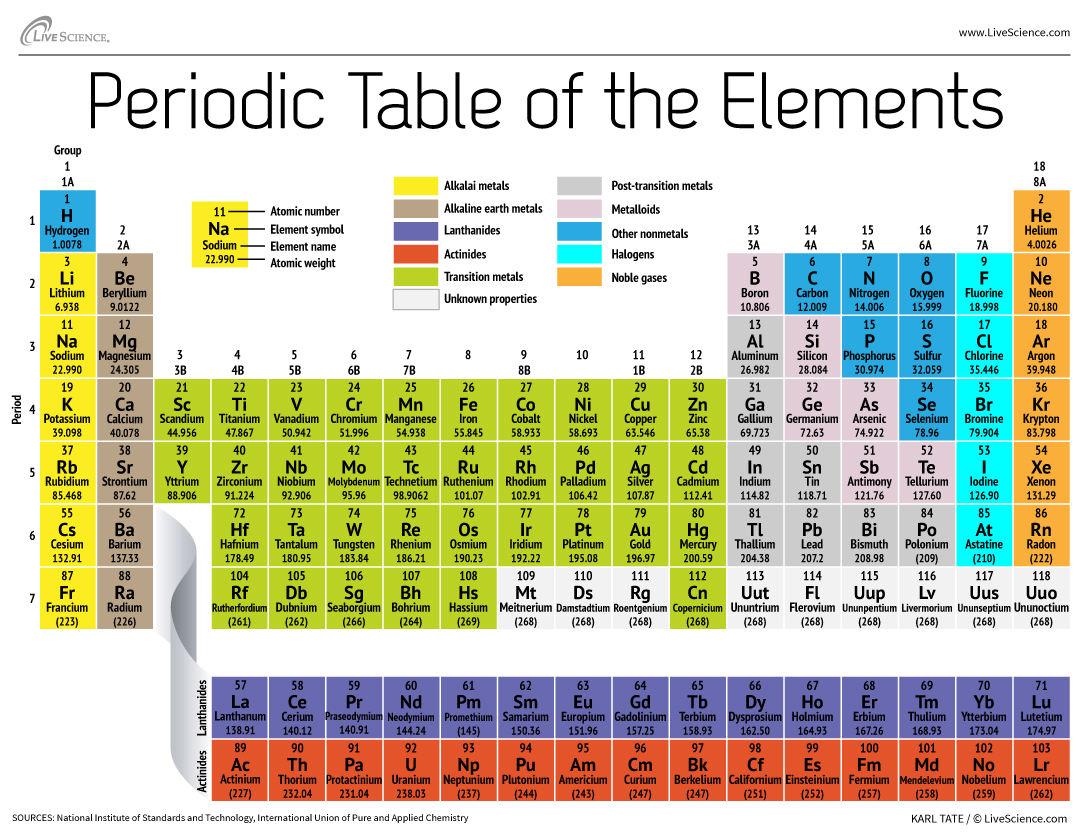Atomic Weight Changed for 19 Elements

Nineteen elements on the periodic table — including gold, cadmium, arsenic and aluminum — are getting their atomic weights adjusted.
The International Union of Pure and Applied Chemistry (IUPAC) announced that they've approved new weights for the elements thanks to more precise measurements and better calculations of the abundance of certain isotopes (atoms of an element with different numbers of neutrons).
The standard atomic weight is the average mass of an element in atomic mass units. One atomic mass unit, or amu, is equal to 1/12 the mass of a single carbon-12 atom. (To put that in perspective, a single carbon atom is roughly equal to 5.857 × 10^-26 ounces.)
To calculate standard atomic weight for an element, scientists average the atomic weights of all its stable isotopes. All atoms of a single element have the same number of protons in their nuclei, but the number of neutrons in the nuclei varies with different isotopes, leading to differences in weight. For example, carbon-12 has six protons and six neutrons. Its slightly heavier cousin, carbon-13, has six protons and seven neutrons. Isotopes also vary in their abundance on Earth, so the more plentiful an isotope, the more it will influence the average. [50 Amazing Facts About Planet Earth]
IUPAC officials said that new calculations of isotopic abundances led to the changed weights for molybdenum, cadmium, selenium and thorium.
The weight change for the nonmetal selenium is particularly notable since it hasn't been revised since 1934, Juris Meija, Secretary of the IUPAC Commission on Isotopic Abundances and Atomic Weights, told LiveScience.
"This does not happen often," Meija wrote in an email. "Usually the advances manifest themselves much faster, so this is an odd element."
Get the world’s most fascinating discoveries delivered straight to your inbox.
For the other 15 elements, the new weights were determined through better measurements and the changes are much more subtle. The weight of gold, for instance, is being updated from 196.966 569(4) amu to 196.966 569(5) amu, where the numbers in parentheses represent the uncertainty in the last digit of the atomic weight.
Though the changes seem miniscule, they could have practical implications for research.
"Knowledge of atomic masses is important to understand the laws of physics," Meija wrote. "A good recent example of that was in 2005 when high-precision measurements of atomic masses allowed researchers to test the validity of the iconic 'E=mc^2.'" (That research, which relied on the atomic masses of silicon and sulfur, was described in the journal Nature.)
The changes, listed below, will be published in a new "Table of Standard Atomic Weights 2013" in the journal Pure and Applied Chemistry in 2014.
molybdenum: from 95.96(2) to 95.95(1) cadmium: from 112.411(8) to 112.414(4) selenium: from 78.96(3) to 78.971(8) thorium: from 232.038 06(2) to 232.0377(4) beryllium: from 9.012 182(3) to 9.012 1831(5) fluorine: from 18.998 4032(5) to 18.998 403 163(6) aluminum: from 26.981 5386(8) to 26.981 5385(7) phosphorus: from 30.973 762(2) to 30.973 761 998(5) scandium: from 44.955 912(6) to 44.955 908(5) manganese: from 54.938 045(5) to 54.938 044(3) cobalt: from 58.933 195(5) to 58.933 194(4) arsenic: from 74.921 60(2) to 74.921 595(6) yttrium: from 88.905 85(2) to 88.905 84(2) niobium: from 92.906 38(2) to 92.906 37(2) cesium: from 132.905 4519(2) to 132.905 451 96(6) praseodymium: from 140.907 65(2) to 140.907 66(2) holmium: from 164.930 32(2) to 164.930 33(2) thulium: from 168.934 21(2) to 168.934 22(2) gold: from 196.966 569(4) to 196.966 569(5)
Follow Megan Gannon on Twitter and Google+. Follow us @livescience, Facebook & Google+. Original article on Live Science.

